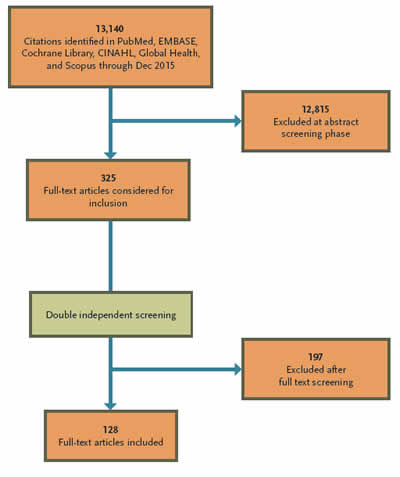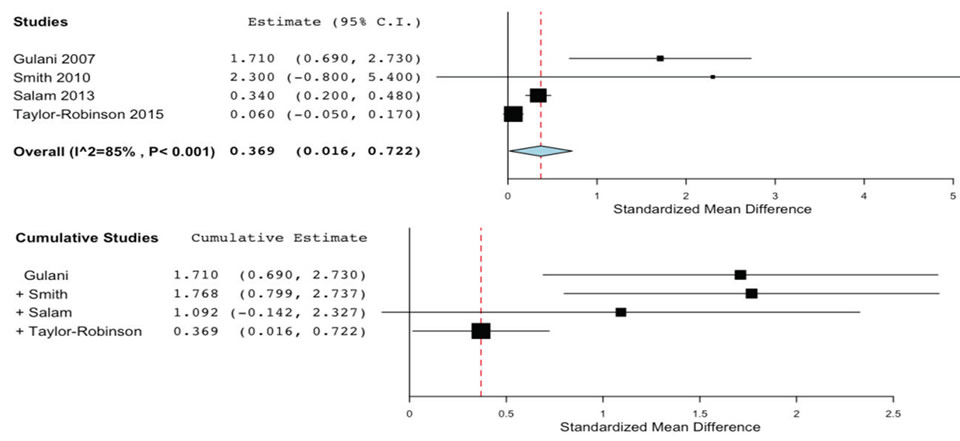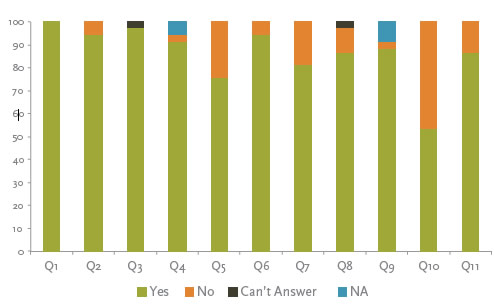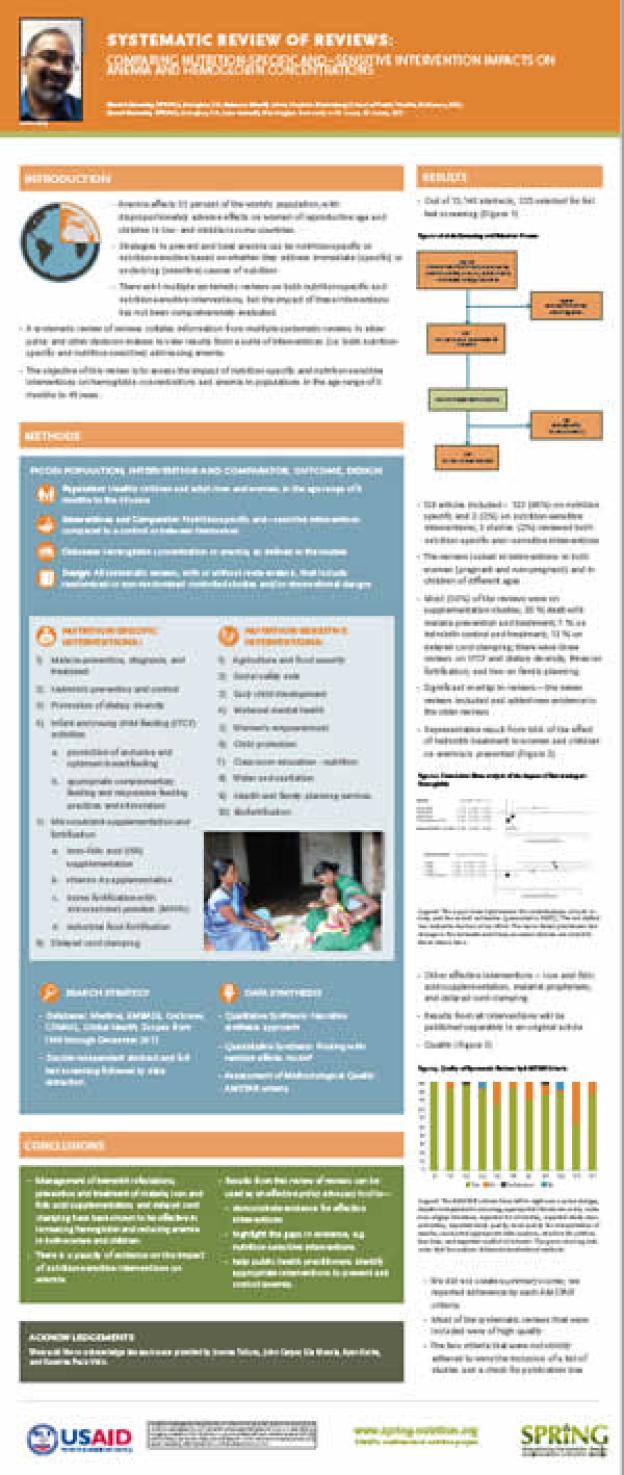Systematic Review of Reviews:
Introduction
- Anemia affects 25 percent of the world’s population, with disproportionately adverse effects on women of reproductive age and children in low- and middle-income countries.
- Strategies to prevent and treat anemia can be nutrition-specific or nutrition-sensitive based on whether they address immediate (specific) or underlying (sensitive) causes of nutrition.
- There exist multiple systematic reviews on both nutrition-specific and nutrition-sensitive interventions, but the impact of these interventions has not been comprehensively evaluated.
- A systematic review of reviews collates information from multiple systematic reviews to allow policy and other decision-makers to view results from a suite of interventions (i.e. both nutritionspecific and nutrition-sensitive) addressing anemia.
- The objective of this review is to assess the impact of nutrition-specific and nutrition-sensitive interventions on hemoglobin concentrations and anemia in populations in the age range of 6 months to 49 years.
Methods
PICOD: POPULATION, INTERVENTION AND COMPARATOR, OUTCOME, DESIGN
- Population: Healthy children and adult men and women, in the age range of 6 months to the 49 years
- Interventions and Comparator: Nutrition-specific and –sensitive interventions compared to a control or between themselves
- Outcome: Hemoglobin concentration or anemia, as defined in the studies
- Design: All systematic reviews, with or without meta-analysis, that include randomized or non-randomized controlled studies and/or observational designs
NUTRITION-SPECIFIC INTERVENTIONS
- Malaria prevention, diagnosis, and treatment
- Helminth prevention and control
- Promotion of dietary diversity
- Infant and young child feeding (IYCF) activities
- promotion of exclusive and optimum breastfeeding
- appropriate complementary feeding and responsive feeding practices and stimulation
- Micronutrient supplementation and fortification
- iron–folic acid (IFA) supplementation
- vitamin A supplementation
- home fortification with micronutrient powders (MNPs)
- industrial food fortification
- Delayed cord clamping
Figure 1. Article Screening and Selection Process

NUTRITION-SENSITIVE INTERVENTIONS
- Agriculture and food security
- Social safety nets
- Early child development
- Maternal mental health
- Women’s empowerment
- Child protection
- Classroom education - nutrition
- Water and sanitation
- Health and family planning services
- Biofortification
SEARCH STRATEGY
- Databases: Medline, EMBASE, Cochrane, CINAHL, Global Health, Scopus from 1946 through December 2015
- Double independent abstract and full text screening followed by data extraction
DATA SYNTHESIS
- Qualitative Synthesis: Narrative synthesis approach
- Quantitative Synthesis: Pooling with random effects model”
- Assessment of Methodological Quality: AMSTAR criteria
Results
- Out of 13,140 abstracts, 325 selected for full text screening (Figure 1)
- 128 articles included – 123 (96%) on nutrition specific and 2 (2%) on nutrition-sensitive interventions; 3 studies (2%) reviewed both nutrition-specific and –sensitive interventions
- The reviews looked at interventions in both women (pregnant and non-pregnant) and in children of different ages
- Most (50%) of the reviews were on supplementation studies; 20 % dealt with malaria prevention and treatment; 7 % on helminth control and treatment; 13 % on delayed cord clamping; there were three reviews on IYCF and dietary diversity, three on fortification, and two on family planning
- Significant overlap in reviews – the newer reviews included and added new evidence to the older reviews
- Representative result from M-A of the effect of helminth treatment in women and children on anemia is presented (Figure 2)
Figure 2. Cumulative Meta-analysis of the Impact of Deworming on Hemoglobin

Legend: The upper forest plot shows the contributions of each review, and the overall estimates (presented in SMD). The red dotted line indicates the line of no effect. The lower forest plot shows the change in the estimate over time, as newer studies are added to the evidence base.
Figure 3. Quality of Systematic Reviews by AMSTAR Criteria

Legend: The AMSTAR criteria from left to right are: a priori design, double independent screening, appropriate literature search, inclusion of grey literature, reported list of studies, reported study characteristics, reported study quality, used quality for interpretation of results, conducted appropriate data analysis, checked for publication bias, and reported conflict of interest. The green shading indicates that the authors followed standardized methods.
- Other effective interventions – iron and folic acid supplementation, malarial prophylaxis, and delayed cord clamping
- Results from all interventions will be published separately in an original article
- Quality (Figure 3)
- We did not create summary scores; we reported adherence by each AMSTAR criteria
- Most of the systematic reviews that were included were of high quality
- The two criteria that were not strictly adhered to were the inclusion of a list of studies and a check for publication bias
Conclusions
- Management of helminth infestations, prevention and treatment of malaria, iron and folic acid supplementation, and delayed cord clamping have been shown to be effective in increasing hemoglobin and reducing anemia in both women and children.
- There is a paucity of evidence on the impact of nutrition-sensitive interventions on anemia.
- Results from this review of reviews can be used as an effective policy advocacy tool to—
- demonstrate evidence for effective interventions
- highlight the gaps in evidence, e.g. nutrition-sensitive interventions
- help public health practitioners identify appropriate interventions to prevent and control anemia.
